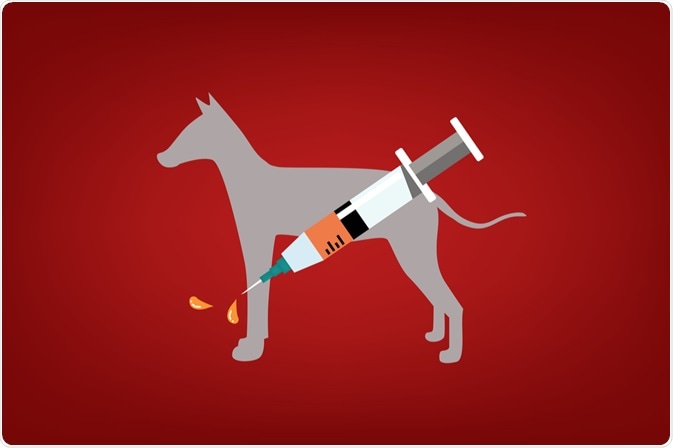If there is a possibility that an individual has come into contact with the rabies virus, it is essential that they seek immediate medical attention. In most cases, it is difficult to determine with certainty if rabies is present; therefore, post-exposure prophylaxis (PEP) is usually recommended as a precautionary measure.

Image Credit: Nicole Rerk / Shutterstock.com
Pre-clinical diagnosis
At present, there are no tests available that are able to diagnose infection with rabies immediately after suspected exposure to the virus. When clinical symptoms begin to present, it becomes possible to diagnose rabies with various diagnostic techniques.
Hydrophobia or aerophobia are signs that are usually specific to rabies and may indicate infection with the virus, but it is not currently possible to confirm rabies diagnosis with testing this early.
If the suspected case of rabies was caused by a bite from an animal that is still in the nearby vicinity, as would be the case if it was a neighbor's pet, for example, it may be possible to test the animal directly for the rabies virus. This can provide knowledge of whether the rabies virus is present sooner, which can avoid unnecessary PEP vaccinations, as well as the financial and emotional burden that can be associated with treatment.
Clinical diagnosis
The incubation period after exposure to rabies virus can vary from as little as one week to more than a year; however, most people experience symptoms after a few months. When symptoms present, they may include:
- Tingling/Itchiness at the infection site
- Fever
- Hyperactivity and excited behavior
- Aggressiveness
- Hydrophobia
- Photophobia
- Aerophobia
However, diagnosis based on clinical presentation alone is difficult; therefore, several tests are needed to confirm the clinical diagnosis of rabies in humans. As a result of the severity of diagnosis with rabies, it is essential that diagnostic tests provide fast results that are reliable, sensitive, and specific.
Direct fluorescent antibody test
The direct fluorescent antibody (DFA) test, which detects antigens of the rabies virus in the brain tissue, was first developed in 1958 and has been widely used in both animals and humans since.
The test involves taking a biopsy of affected tissues, such as those in the brain, which are sent to a laboratory to be analyzed for the presence of rabies. This is done with the use of fluorescently marked antibodies that are applied to the tissue, followed by an observation of the fluorescent effect that allows researchers to depict and analyze the results.
The DFA test is able to produce fast results within a few hours. Additionally, this test is sensitive and specific to the rabies virus. For 95-99% of cases, the DFA test provides an accurate indication of the presence of the disease.
Other diagnostic techniques
Direct rapid immunochemistry (IHC) tests are also accepted to have adequate sensitivity and specificity. This is a suitable alternative to DFA testing, particularly to improve surveillance of rabies in endemic areas.
Intra-vitam techniques are also used to detect rabies in live individuals. It is particularly difficult to obtain an accurate diagnosis of rabies in animals, as the sensitivity to tests can vary significantly according to the stage of the infection, immune system and correct testing techniques. Samples taken from brain tissue, skin tissue, urine or saliva may be used to provide information about the presence of rabies.
References
Further Reading
Last Updated: Jan 18, 2023